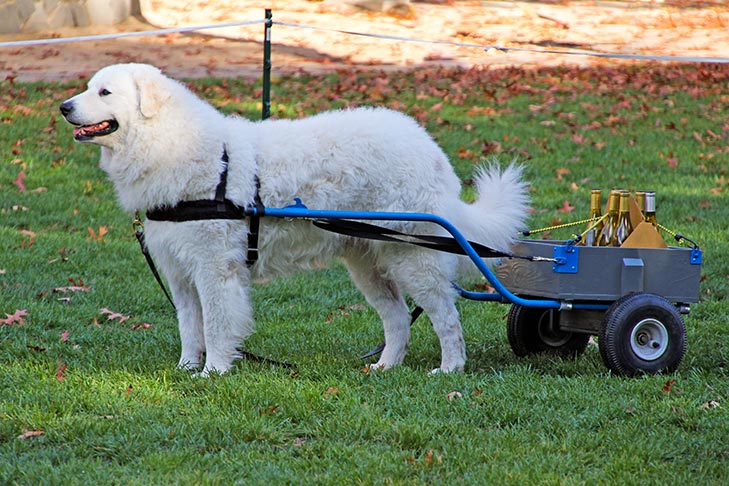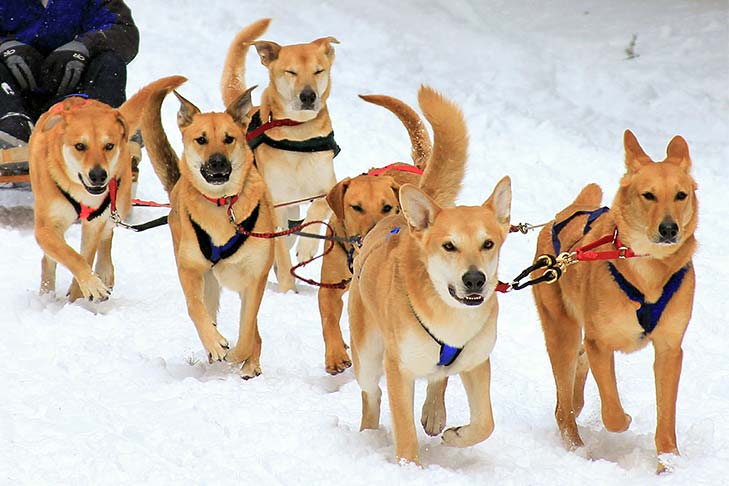We all know about some of the jobs that dogs were bred to do, such as herding, hunting, and retrieving. Today, there are several dog jobs that canines are well-known for, including service dogs, therapy dogs, and search-and-rescue dogs. But some working dogs have specialized jobs that are so unique only canines can complete them. Learn about 15 unique jobs for dogs.
Disease Detectors
In the spring of 2020, the Working Dog Center at the University of Pennsylvania School of Veterinary Medicine started training eight Labrador Retrievers to sniff out COVID-19. But training dogs to sniff out disease is far from new. Many dogs are trained to sniff out rare diseases such as cancer and even Clostridium difficile (C. diff) ,a dangerous bacterium that is transmitted through dog poop.
Truffle Hunters
What would the food world do without these tasty mushrooms? Truffles grow underground near specific types of trees, and for centuries pigs were used to hunt these delicacies. Unfortunately, pigs are not only talented at finding truffles, since they also like to eat them.

Enter the dog, specifically the Italian Lagotto Romagnolo. Originally used as hunting dogs and water retrievers, Lagotti have a keen sense of smell and have been trained to search for truffles. Unlike pigs, they show no desire to eat truffles.
Reindeer Herders
For centuries, people living north of the Arctic Circle used the Finnish Lapphund to herd reindeer. Reindeer provide essential meat and hides to these Scandinavian people, and these thick-coated, powerful, and hardworking dogs are up to the task of herding reindeer.
Art Protectors
The Boston Museum of Fine Arts has come up with a way to protect artwork, delicate materials, wooden objects, and books from bugs: a dog. A Weimaraner puppy, Riley, has been trained to sit down in front of an object when he detects the smell of a bug. Since humans can’t smell insects, Riley can save countless hours, dollars, and lots of heartache by detecting the insects before they do too much damage. The museum chose a Weimaraner because the breed has a keen sense of smell and the stamina to work long hours without becoming bored.
Milk Delivery
All around Europe, especially in the Netherlands, France, Germany, and Belgium, farmers once used dogs to pull small carts of milk from the farms to the cities. Then, they’d sell milk in the streets or markets. Even today, there are a few dog-drawn milk carts in France and Belgium. Pulling these carts, however, tends to be a form of exercise for dogs today.
Carting
Milk isn’t the only thing dogs can cart around. Although carting milk and other goods faded out in many places during the 19th century, carting dogs came back into use during World War I. Breeds such as the Bernese Mountain Dog and Greater Swiss Mountain Dog were used to pull small guns to the front and to bring refugees to safety. Today, dog carting is becoming a popular sport.

Electronics Detectives
We know dogs can detect bombs and drugs. Now some dogs are used to detect electronics, such as a computer, thumb drive, or microchip. The Connecticut State Police have two electronic storage detection (ESD) dogs on their team who can help detect electronic devices.
Runway Wildlife Control
A Border Collie named K-9 Piper had an important job to do at the airport in Traverse City, Michigan. He kept wildlife off the runways, which is federally required by the Wildlife Hazard Management Plan. One of only 10 such working dogs in the country, K-9 Piper had to chase away rodents and the birds of prey they attract from the airport. He also made routine perimeter checks.
Lobster Catchers
Floridian Alex Schulze has trained his two Labrador Retrievers, Lila and Maverick, to swim down to 15 feet deep to catch lobsters on the ocean floor. It took Schulze almost two years to teach the dogs how to swim that deep, and now a fresh lobster dinner is only a dive away. He uses a portion of proceeds from the dogs’ work to promote sea turtle conservation.
Crisis Response
As the co-founder of Crisis Response Canines, John Hunt regularly visits funerals, hospitals, and sites of mass shootings. He brings a small but mighty army of dogs, including his Rottweiler Gunther. Hunt hopes to bring people some light and relief during a tough time.
Fire Dogs
The Fire Department of New York City can take some credit in making the breed famous as fire dogs. Due to Dalmatians‘ expertise as carriage dogs, it was logical that they would serve well running with fire carriages. FDNY began utilizing these dogs as early as the 1870s. Today, some Dalmatians still work in fire houses.

Wine Inspectors
International vintners depend on dogs to find wine-tainting molecules. The Natinga Project has trained dogs to detect 2,4,6-trichloroanisole (TCA), a molecule that imparts a musty odor and flavor to wine, making it undrinkable, in production facilities.
Spit Turners
Imagine standing over an open fire, cranking a giant spit of roasting meat repeatedly and for hours on end. This thankless task fell to dogs from the 16th century through the 19th century. It was such a common practice that a breed was specifically developed in England to do the job.
These stocky dogs, shaped like a Basset Hound with a Bulldog-like head, would run or walk on equipment that was similar to a hamster wheel until the meat was evenly roasted. Never meant as pets, this breed died out with the invention of a mechanized spit turner.
Sled Pullers
What does it take to run hundreds of miles across packed ice and frozen terrain, for days and weeks on end, in freezing temperatures? It takes a lot of grit, guts, and a laser-like focus on getting where you’re going. These are qualities you can find in the Samoyed, Alaskan Malamute, Siberian Husky, and Chinook, some of the most well-known of the sled-dog breeds.

Whale Poop Detectors
Several dogs are important members of the scientific team at the Center for Conservation Biology at the University of Washington. Labrador Retriever Tucker and his canine colleagues go to sea with the scientists to track the majestic Orca whale, which is threatened with extinction. Tucker and the 16 other dogs on the team have been trained to detect the scent of whale poop. These dogs can sense the smell of the “killer whale” up to one nautical mile away.
Collecting and studying feces is the least intrusive and safest way to monitor the movement, health, and diet of the Orcas, and it helps scientists analyze how the species is doing. Tucker can also identify the scent of moose, caribou, wolves, iguanas, and bats. In this way, he’s doing his part to preserve and fight for the survival of other species.

